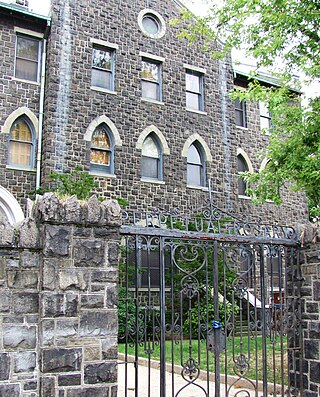Related Research Articles

The Order of Preachers, commonly known as the Dominican Order, is a Catholic mendicant order of pontifical right that was founded in France by a Castilian priest named Dominic de Guzmán. It was approved by Pope Honorius III via the papal bull Religiosam vitam on 22 December 1216. Members of the order, who are referred to as Dominicans, generally display the letters OP after their names, standing for Ordinis Praedicatorum, meaning 'of the Order of Preachers'. Membership in the order includes friars, nuns, active sisters, and lay or secular Dominicans. More recently, there have been a growing number of associates of the religious sisters who are unrelated to the tertiaries.

A nun is a woman who vows to dedicate her life to religious service and contemplation, typically living under vows of poverty, chastity, and obedience in the enclosure of a monastery or convent. The term is often used interchangeably with religious sisters who do take simple vows but live an active vocation of prayer and charitable work.

Munio of Zamora, O.P., was a Spanish Dominican friar who became the seventh Master General of the Dominican Order in 1285, and later a bishop.

Saint Dominic,, also known as Dominic de Guzmán, was a Castilian Catholic priest and the founder of the Dominican Order. He is the patron saint of astronomers and natural scientists, and he and his order are traditionally credited with spreading and popularizing the rosary. He is alternatively called Dominic of Osma, Dominic of Caleruega, and Domingo Félix de Guzmán.

The Order of the Visitation of Holy Mary, abbreviated VSM and also known as the Visitandines, is a Catholic religious order of Pontifical Right for women. Members of the order are also known as the Salesian Sisters or, more commonly as the Visitation Sisters.

Joseph Sadoc Alemany y Conill, O.P. was a Spanish Catholic clergyman, who served most of his career in California. He served as the first Bishop of Monterey (1850–53) and then as Archbishop of San Francisco (1853–84). He was a member of the Dominican Order.

Agnes of Montepulciano, OP was a Dominican prioress in medieval Tuscany who was known as a miracle worker during her lifetime. She is honored as a saint by the Catholic Church.

Juliana of Liège, was a medieval Norbertine canoness regular and mystic in what is now Belgium. Traditional scholarly sources have long recognized her as the promoter of the Feast of Corpus Christi, first celebrated in Liège in 1246, and later adopted for the Catholic Church in 1264. More recent scholarship includes manuscript analysis of the initial version of the Office, as found in The Hague, National Library of the Netherlands and a close reading of her Latin vita, a critical edition of which was published in French by the Belgian scholar and current (2023) bishop of Liège, Jean-Pierre Delville.

The Dominican Order has been present in Ireland since 1224 when the first foundation was established in Dublin, a monastic settlement north of the River Liffey, where the Four Courts is located today. This was quickly followed by Drogheda, Kilkenny (1225), Waterford (1226), Limerick (1227) and Cork (city) (1229). The order was reestablished in the 19th century after having been driven out in the 17th century by laws against Catholic religious orders. During the Penal Laws, as other Irish Colleges were established on the continent, in 1633 the Irish Dominicans established, the College of Corpo Santo, Lisbon and College of the Holy Cross, Louvain (1624-1797) to train clergy for ministering in Ireland. San Clemente al Laterano in Rome, was entrusted to the Irish Dominicans in 1677. In 1855, St. Mary's Priory, Tallaght, was established to train members of the order, who would complete their clerical studies in Rome and be ordained in the Basilica San Clemente.

The Monastery of Our Lady of Prouille or Prouilhe, is the "cradle of the Dominicans", where the first Dominican house, a monastery of nuns, was founded in late 1206 or early 1207. It is located in a hamlet in Languedoc, France, lying between Fanjeaux and Bram, at the point where the road from Castelnaudary to Limoux crosses the road from Bram to Mirepoix.
The Dominican Nuns of the Perpetual Rosary are a religious institute founded in 1880 in Calais, France, by Father Damien-Marie Saintourens, Mother Rose of Saint Mary Werhle and Mother Mary Imelda Gauthier, all of them from the Order of the Preachers.

The Third Order of Saint Dominic, also referred to as the Lay Fraternities of Saint Dominic or Lay Dominicans since 1972, is a Catholic third order which is part of the Dominican Order.
The Sisters of the Blessed Sacrament and Our Lady is an enclosed religious order and a reform of the Dominican Order devoted to the perpetual adoration of the Blessed Sacrament. The congregation was founded in Marseille in 1659 by a Dominican priest, Anthony Le Quieu.

Carisbrooke Priory was an alien priory, a dependency of Lyre Abbey in Normandy. The priory was situated on rising ground on the outskirts of Carisbrooke close to Newport on the Isle of Wight. This priory was dissolved in around 1415.

The Dominican Order was first established in the United States by Edward Fenwick in the early 19th century. The first Dominican institution in the United States was the Province of Saint Joseph, which was established in 1805. Additionally, there have been numerous institutes of Dominican Sisters and Nuns.

The Monastery of the Dominican Sisters of the Perpetual Rosary, known as the Blue Chapel, is a former monastery in Union City, Hudson County, New Jersey, in the United States. It takes its name from the blue tinted windows that were part of the original chapel. Since being abandoned in 2008, the structures and grounds of the complex, which include a cemetery, face an uncertain future.
When referring to Roman Catholic religious orders, the term second order refers to those communities of contemplative cloistered nuns which are a part of the religious orders that developed in the Middle Ages.
The Colettine Poor Clares are a reform branch of the Order of St. Clare, founded by Clare of Assisi in Italy in 1211. They follow the interpretation of the Rule of St. Clare established in 1410 by Saint Colette, originally a French hermit and member of the Third Order of St. Francis.
The Dominican Congregation of Our Lady of the Sacred Heart, better known as the Dominican Sisters of Grand Rapids, is a religious congregation of sisters of the Dominican Third Order established in 1877, with their motherhouse located in Grand Rapids, Michigan. They were founded to provide education to the children of the Catholic populations of Michigan and other regions of the American Midwest. As of 2017, they have 209 sisters in the congregation.
References
- ↑ "Our Monastery". Dominican Nuns | Corpus Christi Monastery. Retrieved 21 May 2019.
- ↑ McCarthy, Thomas P. (1 April 2002). Guide to the Catholic Sisterhoods in the United States, Fifth Edition. CUA Press. ISBN 9780813213125.